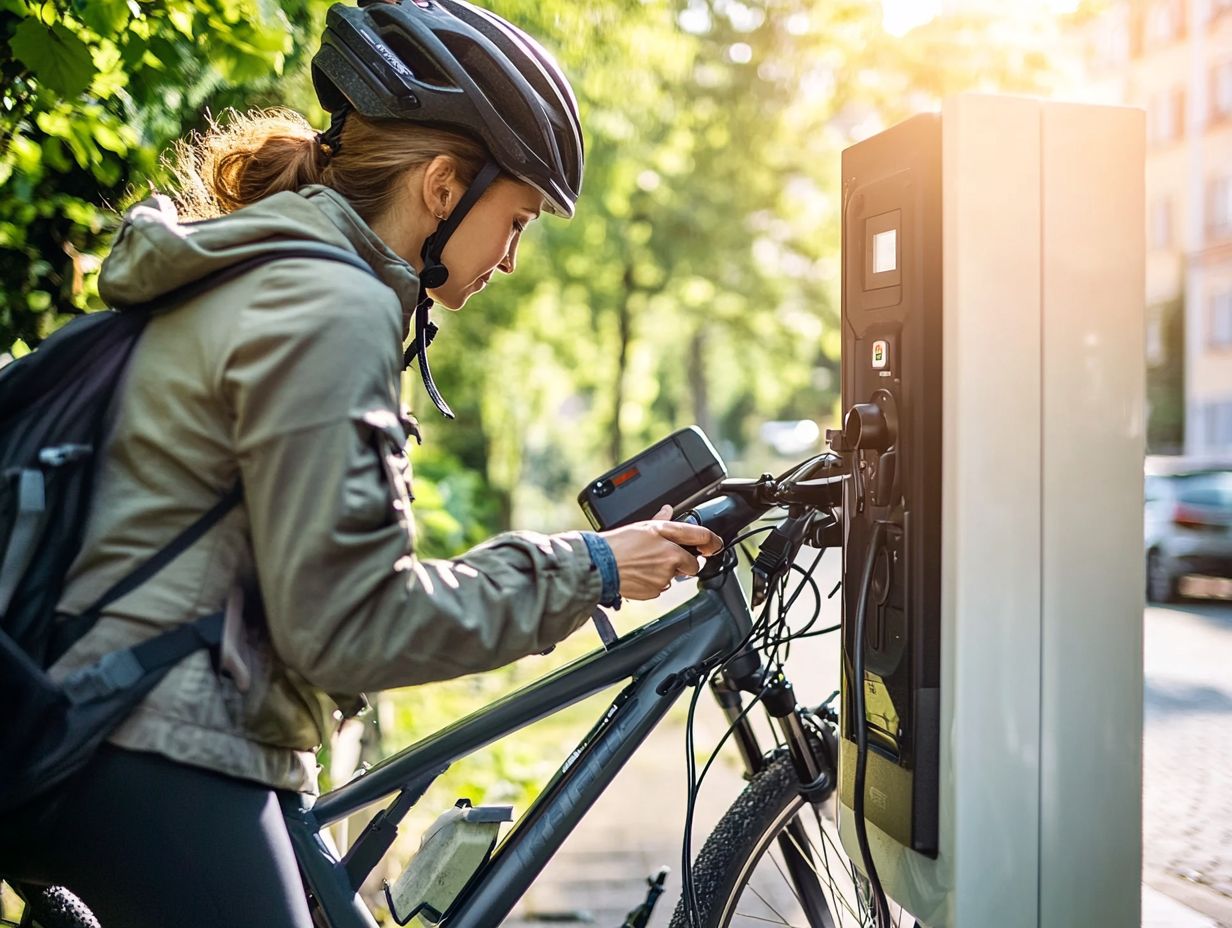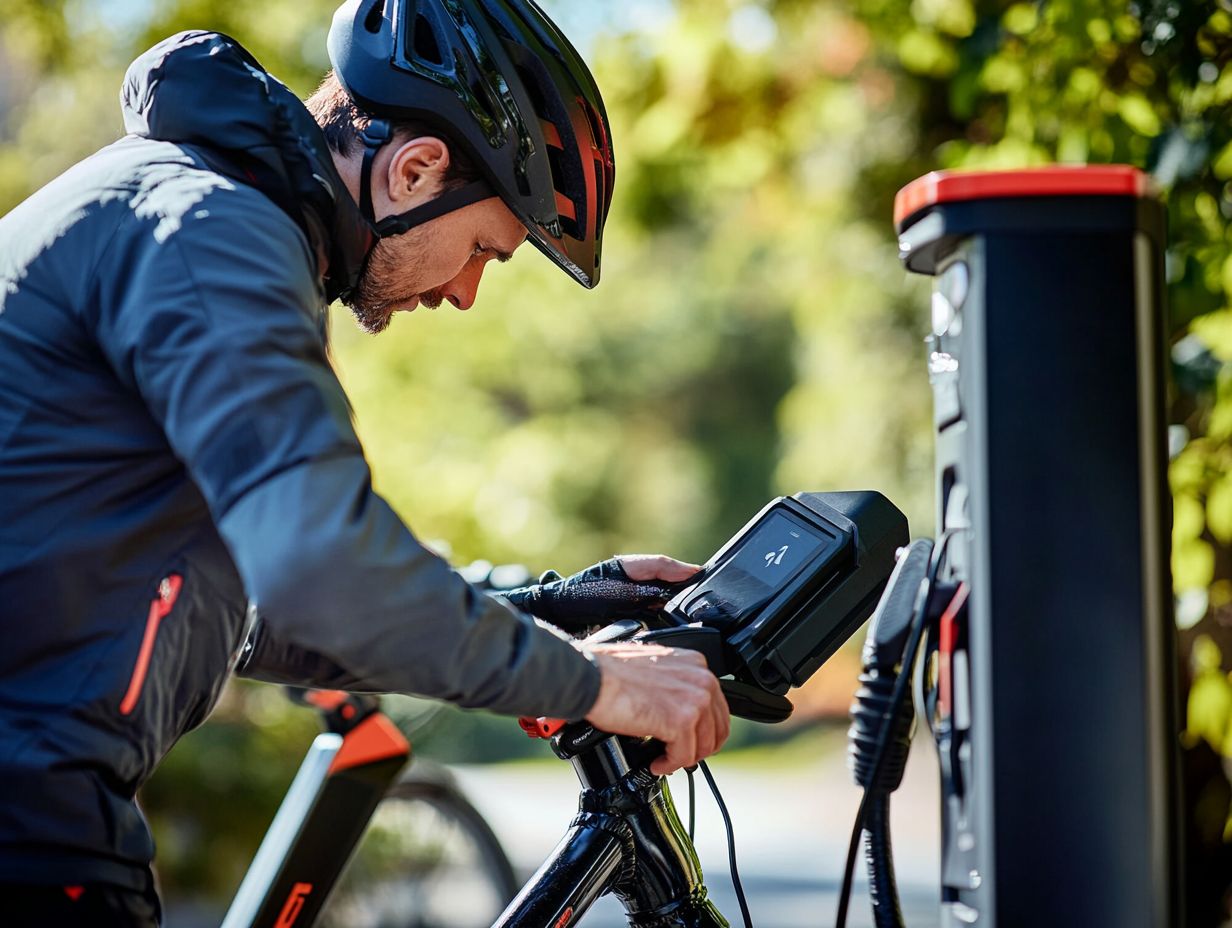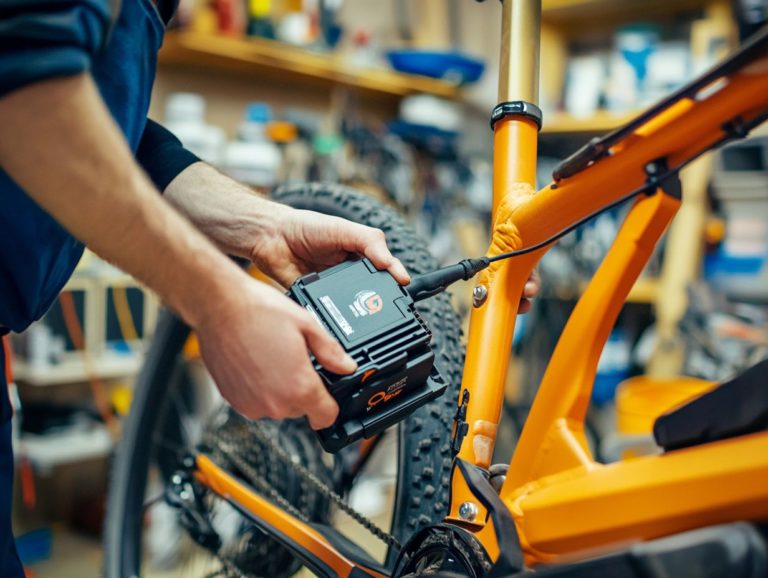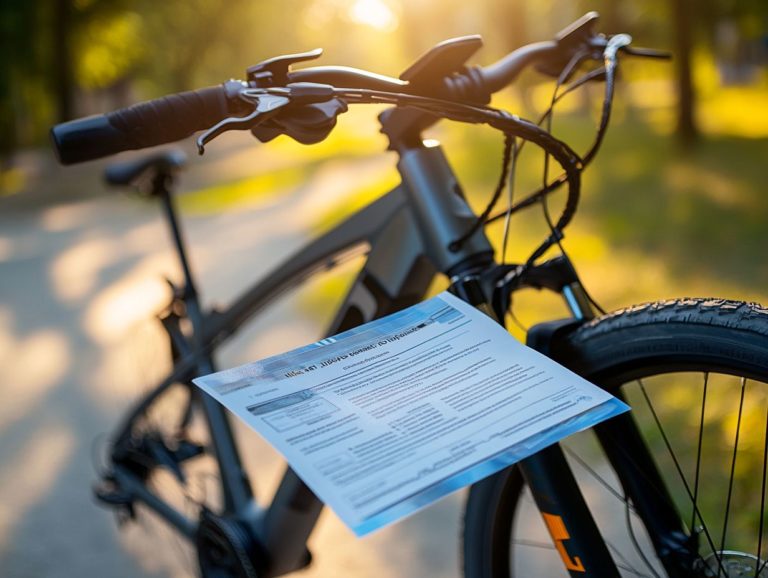How to Properly Charge Your Electric Bicycle Battery
Electric bicycles are revolutionizing your commuting experience by seamlessly merging convenience with eco-friendliness.
To unlock their full potential, it’s crucial to understand their batteries. This article dives into the various types of batteries used in electric bikes, the factors influencing their lifespan and efficiency, and the importance of proper charging techniques.
With a comprehensive guide and essential maintenance tips, you ll learn how to keep your electric bicycle battery in peak condition for a smoother ride and a longer lifespan.
Contents
- Key Takeaways:
- Understanding Electric Bicycle Batteries
- Importance of Properly Charging Your Electric Bicycle Battery
- Step-by-Step Guide to Charging Your Electric Bicycle Battery
- Maintaining Your Electric Bicycle Battery
- Frequently Asked Questions
- What are the best charging practices for my electric bicycle battery?
- How often should I charge my electric bicycle battery?
- Can I overcharge my electric bicycle battery?
- Should I completely drain my electric bicycle battery before charging it?
- Can I use any charger to charge my electric bicycle battery?
- How long does it take to fully charge an electric bicycle battery?
Key Takeaways:

- Understanding the type of battery and the factors affecting its life can help you with proper charging and maintenance.
- Correctly charging your electric bicycle battery can significantly enhance its lifespan, allowing for longer and more efficient rides.
- Follow a step-by-step guide for pre-charging preparation, the charging process, and post-charging tips to ensure the best maintenance for your battery.
Understanding Electric Bicycle Batteries
Grasping the intricacies of electric bicycle batteries is essential for improving your e-bike’s performance and longevity. Various battery types, especially lithium batteries (a type known for efficiency and light weight), are the driving force behind the motor systems that propel e-bikes. Understanding their unique characteristics greatly enriches your riding experience.
Being well-informed about range and lifespan helps you make educated choices regarding the usage and maintenance of your battery, facilitating effective charging cycles and promoting safer rides.
Let’s dive into the fascinating world of e-bike batteries, covering types, performance factors, and the significance of proper charging practices.
Types of Batteries Used in Electric Bicycles
Electric bicycles primarily rely on lithium batteries, featuring various types designed to enhance both performance and safety, much like those in Bosch e-bike systems.
These advanced battery options not only extend life cycles but also offer a higher energy density compared to traditional lead-acid batteries. This results in a lighter overall weight and an improved ride quality.
For example, you can experience a delightful boost in power with features like Turbo mode, amplifying assistance during climbs and tricky terrains while maintaining effective battery management. The Department of Energy highlights these benefits.
Brands like Bosch integrate smart technology, providing alerts about potential safety issues, such as overheating or overcharging. This innovation makes modern e-bikes safer for your regular rides. The shift towards lithium batteries marks a significant advancement in the e-bike industry, enhancing your experience.
Factors Affecting Battery Life and Performance
Battery life and performance in e-bikes depend on various factors, including charging cycles, how to manage charging, and the temperature during charging.
Understanding these elements is crucial for maximizing your investment. Each charging cycle gradually reduces the battery’s capacity, so adopting optimal charging practices can prolong its lifespan.
To manage your battery effectively, avoid fully draining it before recharging. Deep discharges can cause lasting damage. The temperature during charging also plays a crucial role; extreme heat or cold can severely affect performance and longevity.
By keeping these considerations in mind, you can enhance both the effectiveness and lifespan of your e-bike batteries.
Importance of Properly Charging Your Electric Bicycle Battery
Don t risk your battery’s lifespan! Charging your electric bicycle battery correctly is essential for extending its lifespan and enhancing performance.
Doing so helps maintain optimal range while reducing risks associated with improper charging, such as capacity drop and potential fire hazards.
Prioritizing this practice ensures your rides remain safe and enjoyable for miles to come.
Impact on Battery Life and Performance

The way you charge your e-bike battery significantly influences its lifespan and performance, impacting everything from capacity drop to the efficiency of your charging cycles. Ultimately, this affects your energy cost.
By consistently adopting specific charging practices like steering clear of extreme temperatures and avoiding complete depletion you can foster better overall battery health over time. Opting for frequent shallow discharges and partial charges can significantly reduce wear.
This practice extends your battery s usable life while minimizing the risk of overheating, which is known as thermal runaway.
Neglecting proper charging methods leads to a rapid drop in battery capacity. This means less distance per charge, which can be quite frustrating.
Embracing safe charging techniques boosts performance and minimizes potential energy costs tied to constant replacements or inefficient charging.
By being mindful of these strategies, you ll not only enhance your riding experience but also embrace a more sustainable and economical approach to e-bike ownership.
Step-by-Step Guide to Charging Your Electric Bicycle Battery
Charging your electric bicycle battery properly demands a methodical approach. Use a smart charger for effective charge management while minimizing any potential battery risks.
Pre-Charging Preparation
Before you charge your e-bike battery, adequately prepare by checking the system that manages how the battery charges and ensuring you re within the optimal charging range.
Check your battery levels now to prevent costly overcharging; this can shorten the battery’s lifespan. Inspect your charging equipment and connections for any signs of wear or damage.
Adhering to safety protocols is non-negotiable. Ensure the charging area is dry and well-ventilated to prevent overheating.
Taking these preparatory steps significantly enhances the efficiency of the charging process. It maximizes performance while minimizing any risk of hazards.
Being prepared ultimately leads to a smoother charging experience and extends the life of your battery.
Charging Process
The charging process for your e-bike battery should be carried out with a smart charger, which expertly optimizes the time needed to achieve a full charge while effectively managing energy costs.
These sophisticated devices continuously monitor the battery s state of charge and adjust the power supplied accordingly. Utilizing features like programmable charging times, the smart charger takes advantage of lower electricity rates during off-peak hours.
It also assesses the battery’s temperature and current level, significantly reducing the risks associated with overcharging and overheating.
This thoughtful approach ensures a safer charging cycle, ultimately prolonging battery life and enhancing overall performance. These smart chargers offer not just convenience but also serve as vigilant guardians, ensuring your e-bike battery is charged efficiently.
Post-Charging Tips
After charging, follow these tips to avoid risks and keep your battery healthy. Always store your battery in a cool, dry place; extreme temperatures can harm it.
Regularly monitor the battery s status; keep an eye out for any signs of wear or damage to ensure safety.
Avoid overcharging by unplugging the battery once it reaches full capacity. This simple act can significantly safeguard its health.
Consider using a smart charger, which can automatically halt charging once optimal levels are achieved.
By following these straightforward yet effective practices, you’ll maintain maximum capacity and enhance the overall performance of your e-bike. For more detailed guidance, check out our troubleshooting electric bicycle battery issues.
Maintaining Your Electric Bicycle Battery

Maintaining your electric bicycle battery is crucial for ensuring its longevity. It involves a combination of good habits and an awareness of common pitfalls that could pose risks to the battery and shorten its lifespan, including potential fire risks.
Tips for Extending Battery Life
To extend the lifespan of your e-bike battery, follow specific charging guidelines to prevent capacity drop and ensure optimal performance. Also, consider the costs of charging.
Charge the battery only when it reaches a certain level of depletion; aim for a range between 20% and 80%. For more detailed guidance, you can check out how to clean your electric bicycle properly. Avoid letting the battery run very low and overcharging to maintain its health over time, ensuring safety at all times.
Regularly clean the battery terminals to ensure a solid connection. Store your e-bike in a cool, dry place when it s not in use. These simple practices directly influence the battery’s ability to hold a charge, enhancing both longevity and efficiency during your rides.
By implementing these strategies, you can enjoy a reliable power source for your journeys, making each ride that much more enjoyable!
Common Mistakes to Avoid
Avoiding common mistakes with your e-bike battery is essential for mitigating risks, particularly those tied to letting the battery run very low and improper charging cycles.
“`html
Neglecting battery care can drastically shorten its lifespan and introduce safety hazards such as overheating or even fires. It’s easy for riders to overlook the significance of maintaining optimal charge levels and following recommended charging times, which can lead to risks that compromise the performance of their e-bikes. For more information on keeping your ride in top shape, check out this guide on how to maintain your electric bicycle for longevity.
“`
Improper storage like leaving batteries in extreme temperatures can severely damage the cells. To ensure both safety and longevity, educate yourself on best practices, such as:
- Regularly checking charge levels,
- Using the correct charger, and
- Storing the battery in a cool, dry place.
By doing this, you can maintain your battery health and enjoy a safer, more exhilarating riding experience!
Frequently Asked Questions
What are the best charging practices for my electric bicycle battery?
The best way to charge your electric bicycle battery is to follow the manufacturer’s recommended charging method. This will ensure that you do not damage the battery and that it reaches its full capacity.
How often should I charge my electric bicycle battery?

The frequency of charging your electric bicycle battery depends on your usage and the type of battery. Generally, it is recommended to charge your battery after every ride and to never let it fully drain.
Can I overcharge my electric bicycle battery?
It is not recommended to overcharge your electric bicycle battery, as it can cause damage to the battery’s cells. Always unplug the charger once the battery is fully charged.
Should I completely drain my electric bicycle battery before charging it?
No, it is not necessary to completely drain your electric bicycle battery before charging it. In fact, it is better to charge it after every use to maintain its optimal performance.
Can I use any charger to charge my electric bicycle battery?
No, it is important to use the charger provided by the manufacturer or a compatible one. Using an incorrect charger can damage the battery and create a safety hazard.
How long does it take to fully charge an electric bicycle battery?
The time it takes to fully charge an electric bicycle battery varies depending on the battery’s capacity and the charger used. On average, it can take anywhere from 2 to 8 hours to fully charge a battery.






